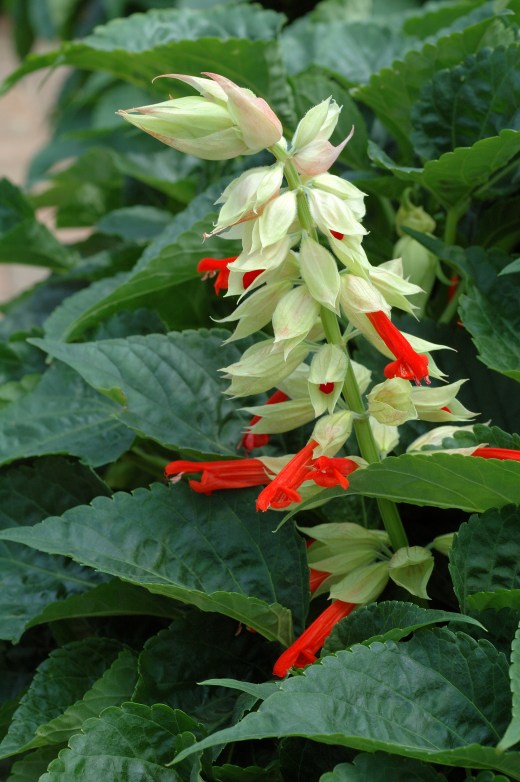Amazing annuals: salvia
Best known for brilliant scarlet flowers, there is much more to salvias than formal bedding.
The very name of salvia conjures visions of seried ranks of neat, dark-leaved plants and vibrant scarlet flowers. I grew up with them and although they were the height of bad taste in the 80s and 90s I think it is time to embrace them again. We are no longer ashamed of bright colours in the garden and it is time to forgive them for being used unimaginatively in rows lined with lobelia and alyssum. It wasn’t their fault.
And, left to its own devices, Salvia splendens (for it is this) is a magnificent plant, bushy and as tall as you. It has been made shorter and earlier-flowering over the years. But even in its modern form it is really deserving of more attention. They do not even have to be red. There are numerous varieties with flowers in purple and bicolours. Bearing in mind the size of the genus and how well many of the species hybridise it is possibly surprising that there are no blue Salvia splendens. But then, with so many blue salvias perhaps it is unnecessary.
The genus salvia is huge and includes herbaceous perennials, shrubs, annuals and includes the common herb sage. The name salvia means ‘to heal’ because of the medical use of sage and other species. Many of the species are aromatic and in many there are also colourful bracts that add to the floral attractions. The other salvia you will know is rosemary – which was a rosemary until recently but is now a sage. And of course chia seeds, Salvia hispanica, native to Mexico. The word chia is an Aztec name meaning oily and we eat chai seeds for their healthy oil content.
There are around 800 species with half of these from Central and South America, and a big concentration around the Med too. They all have square stems, opposite leaves and flowers with a lower lip and hooded upper lip that contains the stamens. The sepals are often colourful and each flower results in four ‘seeds’. Apart from that, the variety is huge.
Salvia splendens is not a true annual, but a tender perennial shrub. But it is usually treated as a half hardy annual.
Salvia viridis is a true annual, from the Mediterranean and, like a lot of salvias that have been cultivated for centuries has has many name changes. You still see it as Salvia horminum and it is commonly called clary sage which is confusing since there is also a Salvia sclarea which is biennial. Salvia viridis grows to about 45cm high. It is a hardy annual that can be sown direct and although the flowers themselves are small, and pale lavender or pink the upper leaves, above the flowers, are vibrantly coloured, either purple, pink or white and last much longer than the flowers themelves. The stems can be cut and dried too, the bracts retaining their colour. Though the flowers are small, like all European salvias, they attract bees. The flowers of the New World salvias tend to be pollinated by birds, explaining why their flower colours embrace yellow and red, unlike the blues and purples of the Old World species.
It is worth mentioning Salvia farinacea which is usually treated as a half hardy annual even though it is strictly perennial. It is native to Mexico and southern USA states and has rather brittle, upright stems and clusters of small indigo flowers on plants about 45cm tall. The leaves are shiny above and often paler or grey beneath. There are various colourways among the varieties including silver white and bicolours. Like S. splendens this one needs to be sown in heat in spring (20c) and the seedlings grown on in frost-free conditions to grow on until ready to plant out in late May. Although S. farinacea is perennial our winters are too wet and cold for plants to survive outside. But, in theory, plants can be kept from one year to the next.




Beautiful photos—great plant!
Blue Rock Horses Frederick County, Virginia bluerockhorses.com
thank you
Did you recently write about these? Salvia farinacea used to be grown as a cut flower crop in about 1986. I do not know how long it was grown. It seems strange now, but it must have done well enough to be grown.
I don’t think I wrote about it recently but I am getting lockdown fever so who knows what I am writing! It seems an odd cut flower crop but it is quite good for drying.
Since 1986, I have not seen it much as a cut flower. I notice it only on rare occasion.